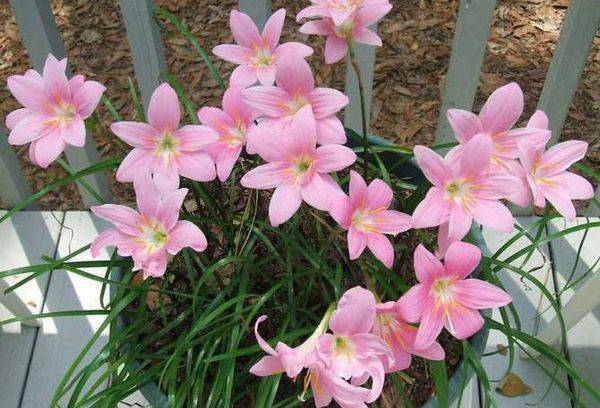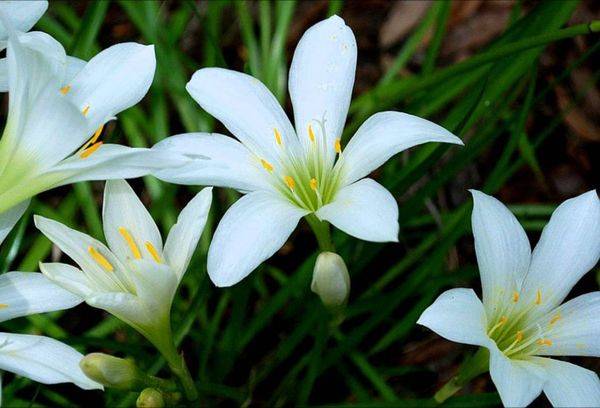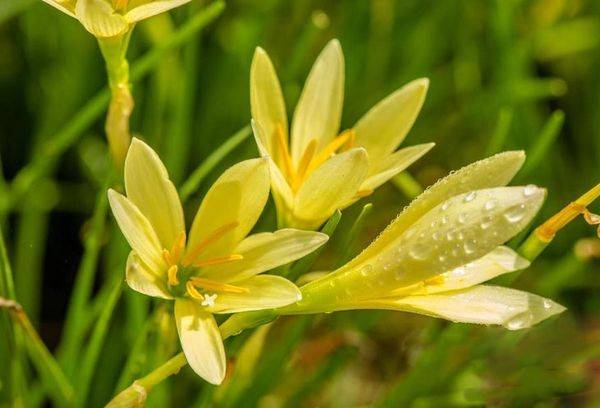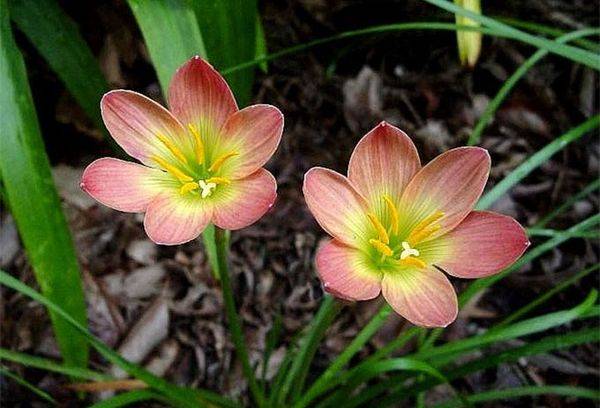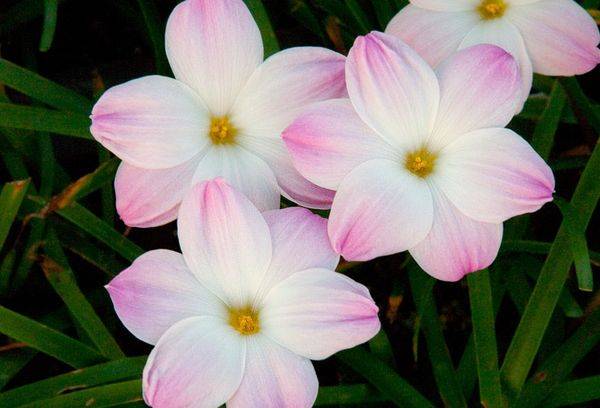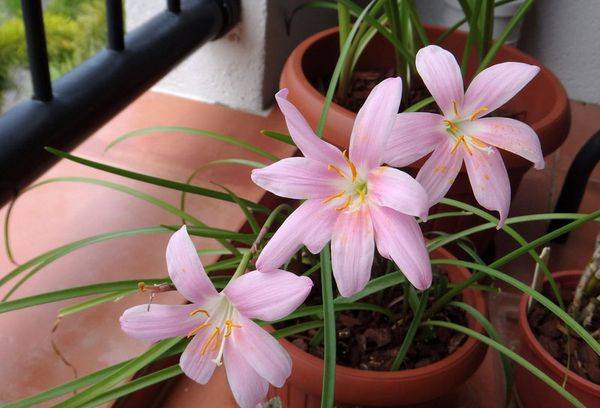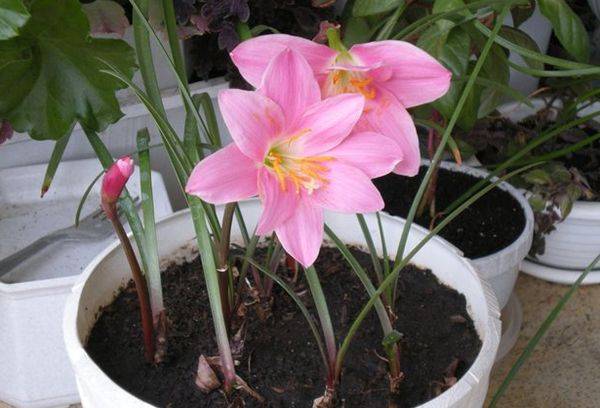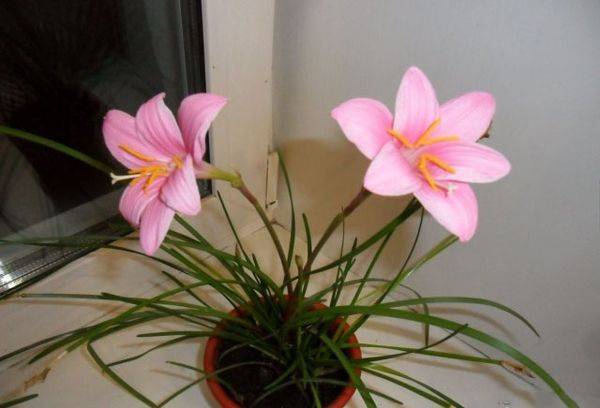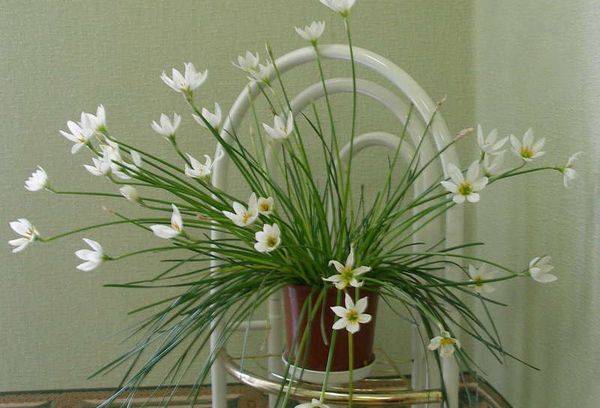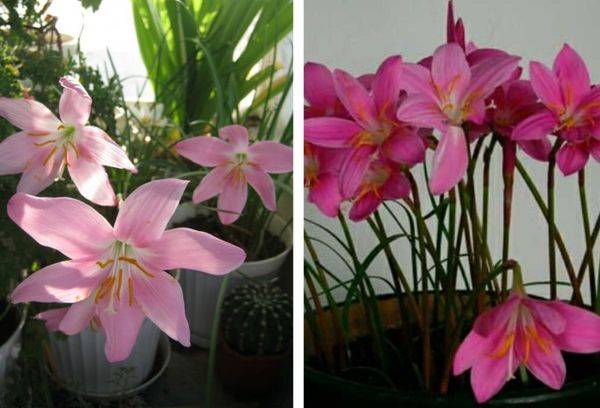How to grow a tropical lily Zephyrantes at home
Content:
Flowers in the house are pleasure, joy, but also great care. Zephyranthes is well mastered and developed at home, but requires attention. It looks like a miniature lily; it comes in several colors - white, pale pink and yellow. A delicate flower blooms quickly and unexpectedly - right before your eyes.
Zephyranthes - description and features
Zephyranthes plant is a grassy bulbous perennial belonging to the amaryllis family. Its native lands are tropical and subtropical territories of central and southern America. This flower is used to an abundance of heat and moisture. Its root is represented by a small round bulb. From one bulb several flowers grow at once. The leaves of the plant are collected in the lower part, often linear, less often tubular and hollow. A thin stalk ends with a medium-sized crocus-shaped peduncle; its color can be white, pink or yellow.
Interesting fact
Zephyranthes are popularly called the “upstart”. This name is associated with its feature - unexpected and fast flowering.
Popular varieties
The color of the petals is the main distinguishing feature of varieties and types of culture.
Atamas It has a small egg-shaped bulb, the neck of which is shortened. Flower lanceolate petals with a pointed edge, their color is dazzling white. The plant feels great at room temperature.
Golden. A yellowish color and an elongated bulb distinguish this variety of marshmallows. The leaves are long and thin; the peduncle is collected in a cup. Favorite flowering period is winter, December or January. Requires systematic moisture of the soil and leaves.
Two-tone. These varieties look bright and unusual, grow them on the windowsill and in the open ground. Their bulb is covered with a dark film and has an elongated elliptical shape. The plant blooms more often in the winter season. A color transition is formed on the inner and outer sides of the petals.
Large flowered. Their distinctive feature is long, reaching up to 30 cm, linear leaves with a longitudinal groove. Peduncles are mainly pink in color with bright orange stamens. The flowering period is long, usually in the spring or summer season.
Technology and growing conditions
The culture has only 10 species, among which there are garden, wild and indoor plants. Varieties of zephyranthes differ from each other in the size of the flower and their color. Light fertile soil is the key to a strong trunk and lush flowering of zephyranthes. For quick seedlings, purityis.decorexpro.com/en/ recommends briefly soaking the bulbs in a solution with a growth stimulant. At the bottom of the pot should lay out the drainage layer. Bulb planting is carried out to the depth of the neck.
Zephyranthes - home care
The flowering time for different types of zephyranthes is different. High-quality lighting and regular care are the main requirements of the southern flower.
House conditions:
- The location. Indoor Zephyrantes loves a lot of light. The best place for him is the window sills on the south side. In summer, flower pots are recommended to be taken out onto the street or balcony; plants can be planted on flower beds in open ground.
- The soil. The ideal base for zephyranthes is a loose and nutritious mixture with neutral acidity. For good growth should be put in equal proportions humus, turf soil and sand.
- Humidity. The tropical environment of origin accustomed this flower to an abundance of moisture in air and earth. The plant needs regular spraying and adequate watering. It is only necessary to stop hydration during bulb dormancy. To prevent rotting, the bulbs are stored dry.
- Temperature. The optimum temperature range for zephyranthes is in the range from 18 to 25 ° C. During the dormant period, the plant requires a lower temperature regime.
- Transfer. In order for the flower to find a new life, its bulbs are planted in 5-10 pieces in low, but wide enough pots. In this case, the neck should remain above the soil level.
- Fertilizer. The plant is fed twice a month. It may be a liquid mineral product suitable for indoor plants. Phosphorus-containing dressing is added to the soil before disembarkation.
Zephyranthes is a fastidious and moody culture. Adequate watering is an important condition for maintaining the health of a tropical flower. Permanent overflow, on the other hand, can destroy a plant. The rotten bulb should be freed from the old soil, washed and dried, and then transplanted into another container. After transplanting, it is better to withstand a three-day break in soil moisture.
How to propagate a plant
After the flowers of the zephyranthes bloom, you should limit watering and wait for the leaves to wither. In late September - early November, the ground part of the plant is cut off and watering is completely stopped. The onion pot should be kept in a cool and darkened place. If you periodically water the bulb, then it will give a lot of children. For the subsequent awakening of the flower, it is necessary to gradually resume hydration and provide the plant with access to sunlight.
The culture has 2 breeding methods:
- Seeds Planting zephyranthes with seeds is a complex and time-consuming process. Peduncles are pollinated artificially using a brush. Ripe seed quickly loses its germination capacity, therefore, it is planted in pots immediately. Only after 2-3 years will a full onion form.
- Kids. They are separated from the uterine bulb during transplantation. During the season, from the mother plant, they can grow from 10 to 15 pieces. Children in pots are seated immediately and in several pieces. Their flowering will begin in about a year.
Tip
The plant needs a period of dry dormancy for more magnificent and abundant subsequent flowering.
Growing problems
Fans of indoor flowers often wonder why marshmallows do not bloom. This occurs if the recommended temperature range of 15 ° C was not observed during the resting period. Lack of flowers can also provoke inadequate lighting, diseases, and excess fertilizer.
Among the most common pests:
- Shield. Covers the leaves and stem of the plant, feeds on cell sap. In this case, the foliage darkens, twists and falls, the stems dry. In a diseased flower, the buds do not bloom and fade, the seed does not tie. For treatment, kalbofos, decis and a 15% solution of actellic are used.
- Whitefly Tiny whitish insects settle on the shoots of zephyranthes, the larvae mature on the inside of the leaves. The pest multiplies rapidly, feeds on plant juice and leaves sugary secretions. Obvious signs of the pest are a weak stem, lack of peduncles, yellowing and falling leaves. The diseased flower must be treated with decis and karbofos every 2-3 days until the destruction of all pests.
- Spider mite. The first visual signs of the pest are the web. At the same time, watering should be intensified and the plant should be well fertilized. To get rid of the disease, the plant recommends a warm shower and drying in the open air.
- Amaryllis worm. A typical pest for this family. The worm begins with bulbs. The affected zephyranthes lags behind other representatives in growth and development. At the same time, it turns yellow and does not bloom. Together with the pest, fungi can attack the flower.Effective control measures - watering with insecticides and fungicides until complete recovery. Badly damaged bulbs usually do not recover.
Growing an exotic zephyranthes flower is quite difficult. A graceful lily full of charm and tenderness will be a worthy reward for all works.
